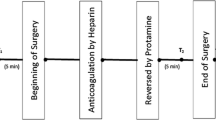Abstract
Several reports demonstrated positive effects of processing residual cardiopulmonary bypass volume using a cell salvage device in conventional open heart surgery via sternotomy on hemostasis. The present study aimed to investigate whether cell salvage processing has the same effects on postoperative blood loss and transfusion in minimally invasive cardiac surgery. Between July 2015 and April 2018, 80 consecutive patients undergoing minimally invasive aortic valve replacement via right anterolateral minithoracotomy were enrolled in the present study. Perioperative outcomes and coagulation data of 40 patients who were retransfused with processed cardiopulmonary bypass volumes were compared with those of 40 patients receiving unprocessed residual blood (control group). Postoperative blood loss in patients receiving processed residual blood was significantly less than that in the control group at 6 h (115 ± 50 vs. 73 ± 33 ml, p < 0.001) and 12 h (167 ± 70 vs. 125 ± 67 ml, p = 0.009) after surgery, and the rate of fresh frozen plasma use after surgery was significantly reduced in patients receiving processed residual blood (18 vs. 0%, p = 0.012). In conclusion, processing of residual cardiopulmonary bypass volume reduced postoperative blood loss and postoperative use of fresh frozen plasma and could be useful for hemostasis in minimally invasive cardiac surgery.

Similar content being viewed by others
Change history
06 April 2019
In the article “Cell salvage processing of residual cardiopulmonary bypass volume in minimally invasive cardiac surgery” published in Heart and Vessels, there were several errors in numerical values.
References
Shaw RE, Johnson CK, Ferrari G, Brizzio ME, Sayles K, Rioux N, Zapolanski A, Grau JB (2014) Blood transfusion in cardiac surgery does increase the risk of 5-year mortality: results from a contemporary series of 1714 propensity-matched patients. Transfusion 54:1106–1113
Society of Thoracic Surgeons Blood Conservation Guideline Task Force, Ferraris VA, Brown JR, Despotis GJ, Hammon JW, Reece TB, Saha SP, Song HK, Clough ER, Society of Cardiovascular Anesthesiologists Special Task Force on Blood Transfusion, Shore-Lesserson LJ, Goodnough LT, Mazer CD, Shander A, Stafford-Smith M, Waters J, International Consortium for Evidence Based Perfusion, Baker RA, Dickinson TA, FitzGerald DJ, Likosky DS, Shann KG (2011) 2011 update to the Society of Thoracic Surgeons and the Society of cardiovascular anesthesiologists blood conservation clinical practice guidelines. Ann Thorac Surg 91:944–982
Konig G, Waters JH (2012) Washing and filtering of cell-salvaged blood—does it make autotransfusion safer? Transfus Altern Transfus Med 12:78–87
Daane CR, Golab HD, Meeder JH, Wijers MJ, Bogers AJ (2003) Processing and transfusion of residual cardiopulmonary bypass volume: effects on hemostasis, complement activation, postoperative blood loss and transfusion volume. Perfusion 18:115–121
Wang G, Beinbrige D, Martin J, Cheng D (2009) The efficacy of intraoperative cell saver during cardiac surgery: a meta-analysis of randomized trials. Anesth Analg 109:320–330
Hiraoka A, Nakajima K, Kuinose M, Totsugawa T, Yoshitaka H (2014) Initial large-dose administration of modified St. Thomas' solution. Asian Cardiovasc Thorac Ann 22:267–271
Sakaguchi T, Totsugawa T, Kuinose M, Tamura K, Hiraoka A, Chikazawa G, Yoshitaka H (2018) Minimally invasive mitral valve repair through right minithoracotomy—11-year single institute experience. Circ J 82:1705–1711
De Somer F, Van Belleghem Y, Caes F, François K, Van Overbeke H, Arnout J, Taeymans Y, Van Nooten G (2002) Tissue factor as the main activator of the coagulation system during cardiopulmonary bypass. J Thorac Cardiovasc Surg 123:951–958
Sibbe J, Kluft C, Brommer EJ, Gomes M, de Joug DS, Nauta J (1984) Enhanced fibrinolytic activity during cardiopulmonary bypass in open-heart surgery in man is caused by extrinsic (tissue-type) plasminogen activator. Euro J Clin Investig 14:375–382
de Haan J, Schönberger J, Haan J, van Oeveren W, Eijgelaar A (1993) Tissue-type plasminogen activator and fibrin monomers synergistically cause platelet dysfunction during retransfusion of shed blood after cardiopulmonary bypass. J Thorac Cardiovasc Surg 106:1017–1023
Schotola H, Wetz AJ, Propov AF, Bergmann I, Danner C, Schondube FA, Bauer M, Brauer A (2016) The effect of residual pump blood on patient plasma free hemoglobin levels post cardiac surgery. Anaesth Intensive Care 44:587–592
Da Q, Teruya M, Guchhait P, Teruya J, Olson JS, Cruz MA (2015) Free hemoglobin increases von Willebrand factor-mediated platelet adhesion in vitro: implications for circulatory devices. Blood 126:2338–2341
Kato GJ, McGowan V, Machado RF, Little JA, Taylor J VI, Morris CR, Nichols JS, Wang X, Poljakovic M, Morris SM Jr, Gladwin MT (2006) Lactate dehydrogenase as a biomarker of hemolysis-associated nitric oxide resistance, priapism, leg ulceration, pulmonary hypertension, and death in patients with sickle cell disease. Blood 107:2279–2285
Rubens FD, Boodhwani M, Mesana T, Wozny D, Wells G, Nathan HJ (2007) Cardiotomy Investigators. The cardiotomy trial: a randomized, double-blind study to assess the effect of processing of shed blood during cardiopulmonary bypass on transfusion and neurocognitive function. Circulation 116:I89–I97
Scrascia G, Rotunno C, Nanna D, Rociola R, Guida P, Rubino G, Schinosa L, Paparella D (2012) Pump blood processing, salvage and re-transfusion improves hemoglobin levels after coronary artery bypass grafting, but affects coagulative and fibrinolytic systems. Perfusion 27:270–277
Campbell J, Holland C, Richens D, Skinner H (2011) Impact of cell salvage during cardiac surgery on the thrombelastomeric coagulation profile: a pilot study. Perfusion 27:221–224
Glauber M, Miceli A, Gilmanov D, Ferrarini M, Bevilacqua S, Farneti PA, Solinas M (2013) Right anterior minithoracotomy versus conventional aortic valve replacement: a propensity score matched study. J Thorac Cardiovasc Surg 145:1222–1226
Totsugawa T, Hiraoka A, Tamura K, Yoshitaka H, Sakaguchi T (2019) Minimally invasive aortic valve replacement through a right anterolateral mini-thoracotomy for the treatment of octogenarians with aortic valve stenosis. Heart Vessels 34:462–469
Author information
Authors and Affiliations
Corresponding author
Ethics declarations
Conflict of interest
The authors declare that they have no conflict of interest.
Additional information
Publisher's Note
Springer Nature remains neutral with regard to jurisdictional claims in published maps and institutional affiliations.
Rights and permissions
About this article
Cite this article
Muraki, R., Totsugawa, T., Nagata, K. et al. Cell salvage processing of residual cardiopulmonary bypass volume in minimally invasive cardiac surgery. Heart Vessels 34, 1280–1286 (2019). https://doi.org/10.1007/s00380-019-01365-6
Received:
Accepted:
Published:
Issue Date:
DOI: https://doi.org/10.1007/s00380-019-01365-6



